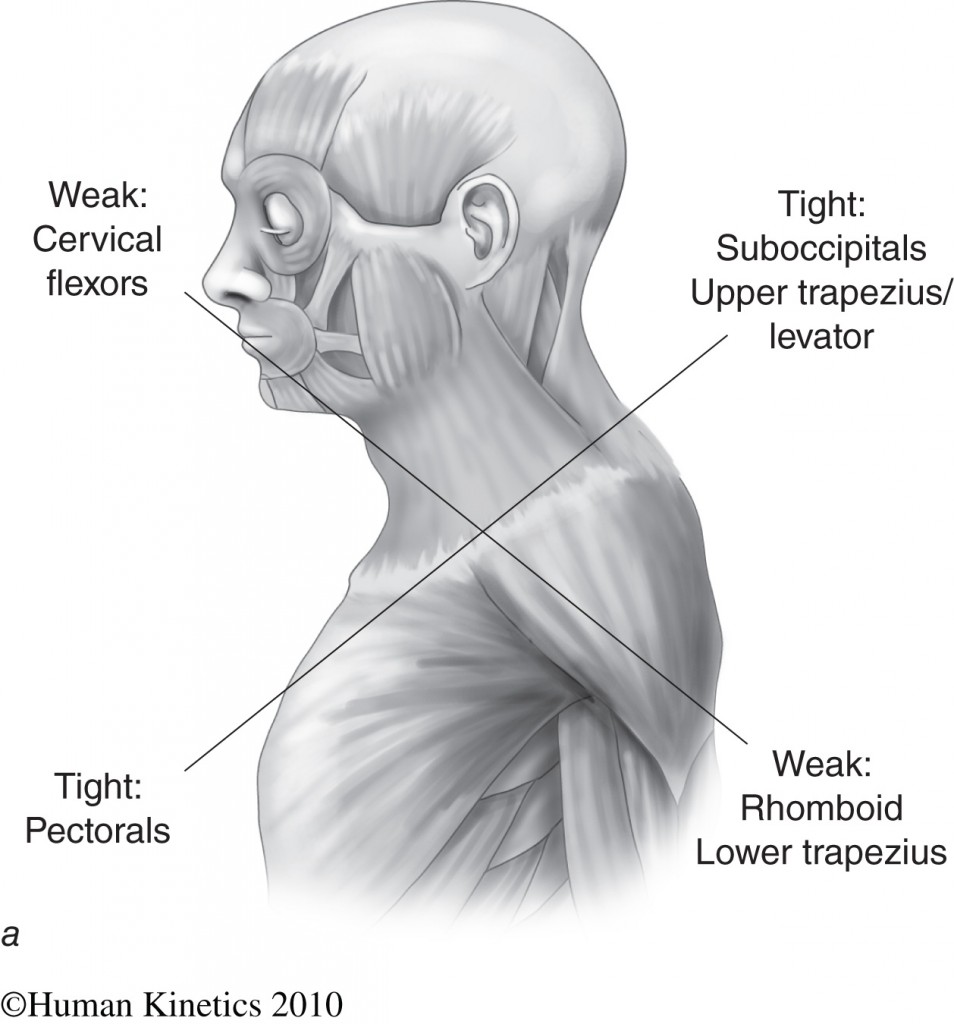
Identifying Upper Cross Syndrome for Dummies (Part 1)
Written by Michele Vieux
Do you know where your traps are? What about your trapezius? If you are shaking your head “no”, then chances are you are also activating your upper traps – that muscle we use to shrug our shoulders when we don’t know the answer to a question. “Traps” is short for trapezius. The trapezius helps to stabilize the shoulder a majority of the time – so much of a majority that it is often overused – leading to a set of conditions called Upper Cross (or “upper crossed”) Syndrome.
Upper Crossed Syndrome (UCS) is described as a muscle imbalance pattern located at the head and shoulder regions. It is most often found in individuals who work at a desk or who sit for a majority of the day and continuously exhibit poor posture. In UCS, tightness of the upper trapezius and levator scapula on the dorsal side crosses with tightness of the pectoralis major and minor. Weakness of the deep cervical flexors ventrally crosses with weakness of the middle and lower trapezius. This pattern of imbalance creates joint dysfunction, particularly at the atlanto-occipital joint, C4-C5 segment, cervicothoracic joint, glenohumeral joint, and T4-T5 segment. (Janda 1988)
What does all this mean? Basically, it means that when 4-5 muscle groups get too tight it can lead to a chain of events that can create shoulder instability, dysfunction and eventually pain and injury. The culprits are the trapezius and levator scapula (which help raise and lower the shoulder blades), the pectoralis major and minor (in your chest), and the sternocleidomastoid (the bulging muscles along the side of your neck).
Our healers from Thrive Wellness – Tara Parsons and Heidi Fearon – and I have noticed too many clients with the trappings of UCS and associated shoulder pain. The “shoulder” problems we see are mostly coming from the overuse of the traps and neck.
So, what do you look for to identify UCS? Look for these specific postural changes – which decrease glenohumeral stability (shoulder joint) – that are most commonly seen in UCS:
-
Forward head posture – Picture the little old lady crossing the street who can’t see where she’s going because her head is jutting forward of her shoulders so she can only look to the ground in front of her and not up or ahead.
-
Increased cervical lordosis and thoracic kyphosis – The hunchback. Think about how your shoulders must compensate in the overhead position if you have a even the beginnings of a hunchback.
-
Elevated and protracted shoulders – Also known as “douchebag shoulders” by our friend Kelly Starrett, author of the bestseller, “Becoming a Supple Leopard”, this is when your pecs are so tight and your sub-scapular muscles (the ones between and below your shoulder blades) are too weak to hold your shoulders back so they round forward instead.
-
Rotation or abduction and winging of the scapula – Abduction means the (scapula) bone is moving away from the body which gives it a ‘wing’ looking effect when looking at it from the side or rear views. If someone can slide their fingers under your shoulder blade and grab on to it, your scapulae are winging.
Besides looking terrible because you are walking around with douchebag shoulders and getting tired of having your wife or mother nag you to stand up straight or mind your posture, you should be concerned about what these postural changes can mean to your body’s short and long-term health and well-being. One or more of these symptoms can mean that your shoulders are unstable and therefore at risk for injury. Or that some areas are overcompensating for the dysfunction, causing damage. Or that because some areas are over compensating, they are turning off other areas that should be working but aren’t, which causes instability. Or maybe your shoulder girdle is just weak. You may already be feeling the effects in the form of nerve pain in the neck and arm(s), instability while overhead, headaches, and the appearance of rotator cuff problems. In the long term, UCS can also lead to osteoarthritis and degenerative joint disease.
After watching people move for the past seven years and with special focus on the traps in the past couple months, I have noticed a trend that must be stopped and then corrected – upper trap shrugging to set the shoulders. The time to stop this is now…well, almost now.
What exercises or physio therapy do you suggest to correct UCS?
No link to part 2?
Informative article, thanks! So, any suggestions on how to cure this issue .. especially for us desk bound individuals…
You can’t imagine how relieved I was to read this. I have been through 18 months of pain, two cortisone shots for bursitis, increasingly intense spasms of the upper trapezius when I lie down to the point where I’m now depressed and sleep deprived. I’ve seen a chiropractor, an osteopath, three physios and 2 gps and none of them could figure it out. This is EXACTLY what has happened! I was starting to think I was completely mad. Now pleeeease tell me how to fix it before I O.D. on the many painkillers they’ve thrown at me.
Great article!
sweet.
This is awesome so insightful, I have the upper cross syndrome but Its great to be aware of it, as I have a background in boxing and sit at a computer all day!
I had a cortisone shot about 5 weeks ago in my shoulder, for precisely these exact reasons although never heard it called UCS. Very good info, I look forward to part 2!
Very good information! Thanks Michele!
What a great article, thanks Michele!